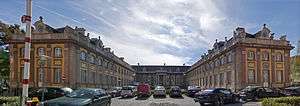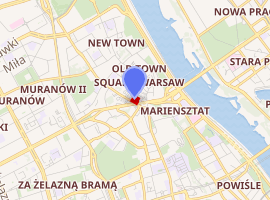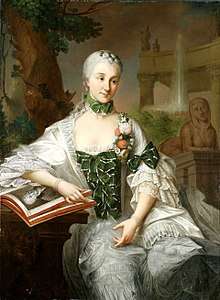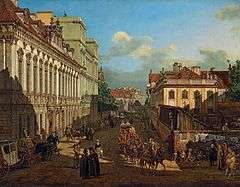Branicki Palace, Warsaw
The Branicki Palace (Polish: Pałac Branickich) is an 18th-century magnate's mansion in Warsaw, Poland. It is located at the junction of Podwale and Miodowa Streets.
| Branicki Palace Pałac Branickich w Warszawie (in Polish) | |
|---|---|
 Branicki Palace - courtyard. | |

| |
| General information | |
| Architectural style | Rococo |
| Town or city | Warsaw |
| Country | Poland |
| Construction started | 1740 |
| Completed | 1753[1] |
| Demolished | 1940s[2] |
| Client | Jan Klemens Branicki |
| Design and construction | |
| Architect | Johann Sigmund Deybel |
History
The Palace is one of three with the same name in Warsaw. This particular Branicki Palace is on Miodowa Street (the others are located on Nowy Świat Street and Na Skarpie Avenue).

The original building that stood where the palace now stands was a 17th-century mansion of the Sapieha family sold in the beginning of the 18th century to Stefan Mikołaj Branicki.[3] This led to the current palace, built in 1740 by Johann Sigmund Deybel for Grand Crown Hetman Jan Klemens Branicki. Jan Henryk Klemm (1743), Jakub Fontana (1750) and sculptor Jan Chryzostom Redler also participated in the construction.
The now rococo palace was inspired by French palaces.[4] The layout was shaped like a horseshoe, with a central part corps de logis and two side wings. The building was set back from the street by a cour d'honneur, a symmetrical courtyard set apart in this way, at which the honored visitors arrived. The façades were balanced with admirable rococo decoration and rooftop windows.[4] The main entrance was decorated with a portico of four columns with sculptures on the top. The interiors were decorated in the rococo style by Johann Sigmund Deybel and Jakub Fontana. Later, a pavilion called "Buduar" was added to the south wing at the back.[5]
The Branicki Palace previously had been called the Mrs Krakowska Palace, because after Branicki's death the property was inherited by his beautiful wife Izabella Poniatowska (1771), sister of king Stanisław August Poniatowski (Izabella was a daughter of Stanisław Poniatowski, Castellan of Kraków). She held a salon in the palace, and became known as a patron and gatherer of artists, intellectuals, and statesmen in the era of Enlightenment in Poland.[3]
Shortly afterwards the Branicki Palace was sold in 1804 to the general Józef Niemojewski. The new owner improved the palace - two side outbuildings were added to the palace complex in 1804-1808 by architect Fryderyk Albert Lessel.[3] From 1817 the palace was inhabited by the Stanisław Sołtyk.
During the Second World War, the estate was badly damaged (it was burned down in 1939 and demolished by the Germans during the Occupation of Poland),[3] but after the war it was completely restored. It was rebuilt in 1967, based on paintings by Bernardo Bellotto,[6][7] and now houses Warsaw City Hall.
Images


Ruins of the Branicki Palace in Warsaw, 1945 .jpg)
The east wing of the palace 
The west wing of the palace The palace elevation 
The palace gate Architectural details of the palace
References
- In-line:
- "Pałac Branickich". Wieżowce Warszawy (in Polish). Archived from the original on 2012-02-25. Retrieved 2008-02-17.
- "Warszawa oskarża". ojczyzna.pl (in Polish). Archived from the original on 2012-02-25. Retrieved 2008-02-17.
- "Pałac Branickich". naszemiasto.pl (in Polish). Retrieved 2008-02-17.
- Stefan Kieniewicz, ed. (1984). Warszawa w latach 1526-1795 (in Polish). Warsaw. ISBN 83-01-03323-1.
- "Skarby rokokowej Warszawy". swiadectwo (in Polish). Retrieved 2008-02-17.
- Penelope Fitzgerald (1989-10-29). "How an Artist's Vision Became Ours". nytimes.com. The New York Times. Retrieved 2008-02-17.
- "Pałac Branickich na ulicy Podwale". ewarszawa.com (in Polish). Archived from the original on 2008-03-11. Retrieved 2008-02-17.
- General:
- "Pałac Branickich". naszemiasto.pl (in Polish). Retrieved 2008-02-17.
See also
| Wikimedia Commons has media related to Branicki Palace in Warsaw. |
- Branicki Palace, Białystok
- Palace under the Four Winds
- Brühl Palace, Warsaw